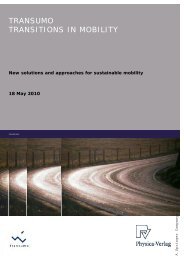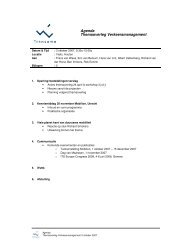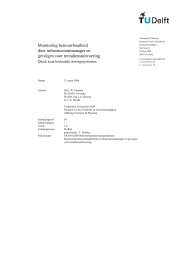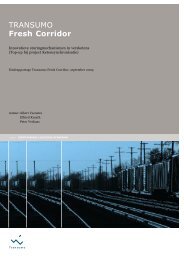Casestudie Breakdown prediction Contell PILOT - Transumo
Casestudie Breakdown prediction Contell PILOT - Transumo
Casestudie Breakdown prediction Contell PILOT - Transumo
Create successful ePaper yourself
Turn your PDF publications into a flip-book with our unique Google optimized e-Paper software.
1. Descriptive models<br />
2. Numerical models<br />
3. Graphical models<br />
4. Statistical models<br />
5. Functional models<br />
6. Analytic models<br />
Descriptive models represent the most abstract level of data analysis. They describe<br />
circumstances just by the use of verbal phrasing. ([Berthold99], p. 171) The sentence<br />
“The warmer the room ambient temperature, the higher the electric power<br />
consumption of a freezer”, for instance, already composes a small descriptive model.<br />
Although this kind of model does not give precise information of magnitude, it offers<br />
enough knowledge within many situations.<br />
By contrast, a descriptive model is not capable of solving the existing problems within<br />
the setting of sensor based temperature monitoring, because it is too abstract. A<br />
statement like “a cooling device is malfunctioning in case of reaching an uncommon<br />
temperature without being influenced externally” describes the problem very<br />
accurately. But it does not mention methods how to recognize these influences.<br />
Numerical models offer a more detailed description in form of a table. ([Berthold99],<br />
p. 171) Relating to the exemplified descriptive room ambient temperature model, an<br />
associated numerical model lists concrete room ambient temperatures versus the<br />
corresponding electric power consumption. The third level of data analysis is just the<br />
graphical representation of a numerical model. This is especially useful to get an<br />
overview of large datasets within very short time. 44<br />
The current methodological approach of predefining critical limits to classify the<br />
current state of a monitored system is a numerical model, because every<br />
temperature value is assigned to either “cooling device is OK” or “cooling device is<br />
malfunctioning” The graphical abilities of the introduced products, suffice to comply<br />
also with the third level of data analysis.<br />
The last three levels of data analysis are not based on verbal phrases or sample<br />
values but on mathematical “descriptions” for all values to get a higher detail.<br />
Statistical models use measures like, for instance, the mean temperature or the<br />
standard deviation to illustrate coherences ([Berthold99], p. 172). A sample model<br />
44 See section 3.2.1 for details<br />
56
















